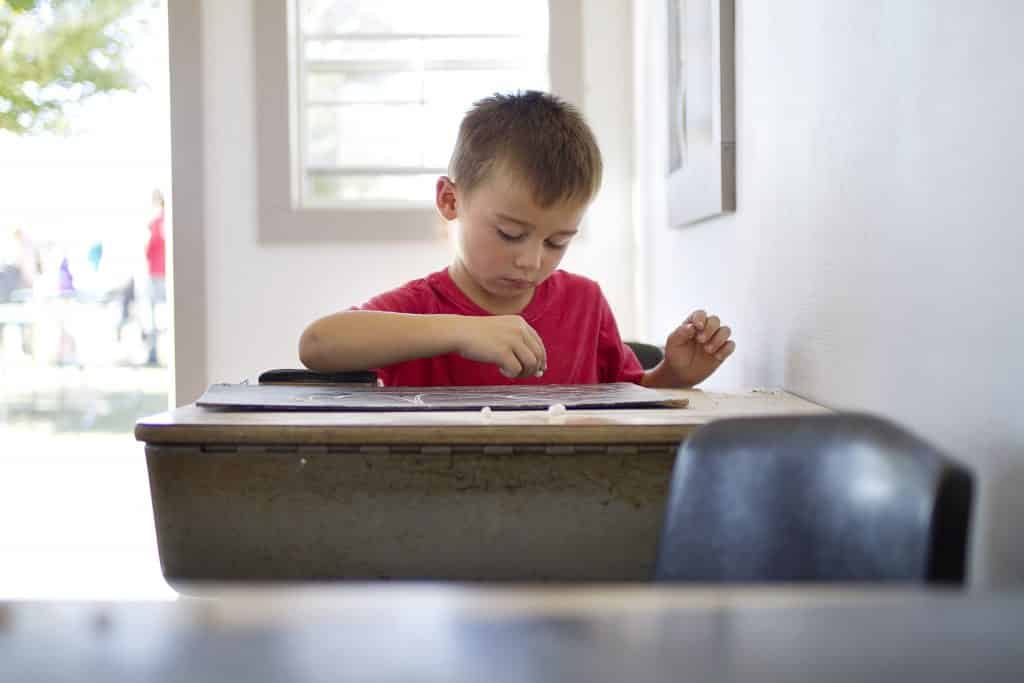A common reason for referral to an Occupational Therapist is for handwriting. Whether the child has an interesting grasp, becomes tired during handwriting tasks, or refuses to attempt a handwriting task. This is where a child may benefit from seeing an Occupational Therapists. However, there are some things that you can try before seeing an OT.
Using a good pencil, ensuring the right grip, strengthen fine motor muscles and practicing letter formation are a few effective ways to improve your child’s handwriting. These practices, apart from improving the style of handwriting, can also enhance their handwriting speed which is important to their academic performance, especially during timed assessments.
Though schools, especially in the younger years, practice handwriting with the children, handwriting development is a process that doesn’t happen at the same rate for all children. Every child has a distinct brain structure and thus, grasp the skill at a different pace.
It requires great practice to make the process effortless and good at the same time. However, if your child’s handwriting is messy and slow, this article outlines some strategies to help them improve it.
How do I know if my child’s handwriting needs improving?
Often we get teachers and parents self-referring their child for handwriting needs. The reasons children get referred to Occupational Therapists include:
- An adult (either teacher or parent) has noticed that the handwriting is illegible
- The child is refusing to complete any handwriting tasks
- The child is complaining of pain in their hand during handwriting tasks
What is illegible handwriting?
Illegible handwriting is typically messy and hard to read. Poor handwriting in children can be identified by a range of factors including:
- Problems in holding a pen or a pencil appropriately
- Lack of control in pencil movement
- Difficulty in letter formation
- Improper spacing between words
- Floating words and sentences
However, the good news is that constant practice can improve handwriting skills. Parents and teachers can encourage children to follow a few effective practices to make their handwriting fast, clean and orderly.
What handwriting skill should I focus on with my child?
Before you go through the strategies below, it is important to pay attention to the difficulties your child is currently facing while writing.
- Are they getting tired too easily?
- Is it challenging for your child to grip the pencil?
- Do they know how to form a letter?
- Do they have trouble with spelling the word?
Observe your child closely to understand their problems and find solutions accordingly. You can also talk to your child’s class teacher for their feedback and suggestions. If you are still not sure, you can get an Occupational Therapist to assess your child’s handwriting skills to determine the underlying problem area.
The Impact of Technology on Handwriting
Whether it’s writing down a shopping list, filling up a form or writing an exam, handwriting is an important skill to be learnt by all. Though in recent years, technological shifts have changed the way of communication where typing can be used as an alternative to handwriting (in many cases). However, handwriting remains an important part of our daily life, especially in education and employment.
When compared with typing, handwriting activates the brain far better. Handwriting is an activity that involves both motor and cognitive skills. Good handwriting is responsible for activating visual perception of letters and thus, contributes to reading fluency. It positively impacts grades and is considered to be a predictor of success.
Remember, in most formal education systems, assessments are done on the basis of written work. Thus, without fast and clear handwriting, children might miss out on different learning opportunities. Although there may be changes in the coming years as they transition to using technology, there are still significant benefits of handwriting.
Children who have Difficulty with Handwriting
Children who experience difficulty in handwriting can experience poor self-esteem. As handwriting is an overarching skill that requires many fundamental skills (e.g. spelling, letter formation, fine motor skills, planning etc.), difficulty in a few fundamental skills can make handwriting significantly more challenging.
For example, children who produce written work that is illegible might find it tough to proofread their own work. Due to this, they often fail to spot their own mistakes and thus can lead to poor grades in assignments and exams. This might trigger a loss of confidence in children.
As handwriting is an essential part of learning, students are often judged by their handwriting. Even if a child has a strong knowledge base and creates good content, they might achieve lower grades due to teachers not being able to read their writing.
Good handwriting can help your child in many ways. Whether you want to make your child achieve good grades or communicate with others effectively, consider improving their handwriting to make them happy, successful, and confident.
How To Improve Handwriting For Kids?
Here are some of the effective ways you can help your child improve their handwriting.
Use a Good Pencil
To do the job well, we must use the right tools. Therefore, the first step to improve handwriting is making sure we are using the correct pencil for them. If you are providing your child with the wrong pen or pencil, handwriting can become so much harder.
For younger children who have less developed fine motor muscles, thicker pencils work better. Triangular pencils are also a great tool to help your child place their fingers in the ideal position.
Correct Pencil Grasps
One of the most effective ways to improve handwriting is when children learn to hold their pencil correctly. In most cases, handwriting suffers due to the poor control of the pencil. Thus, to make them achieve good handwriting, encourage them to maintain the right grip and position.
‘Tripod grasp’ is known to be the most efficient way of holding a pencil. Here, you position the pencil between your thumb and the index finger. While holding the pencil in this position, ensure that it comfortably rests over your middle finger. This will allow your child to experience a relaxed grip which is important for smooth handwriting. Additionally, this grip also ensures less strain over your child’s fingers.
Sometimes, as Occupational Therapists, we also recommend pencil grips to help children learn how to hold the pencil correctly. Check out our Youtube video about pencil grasps: https://youtu.be/S8DfMeX1dx4
Check the Writing Speed
Handwriting speed is definitely an area of concern, especially when the child has trouble maintaining the right pace to keep up with classwork. They may have trouble copying work off the whiteboard or getting all their thoughts down during a timed assessment.
Although it is important to improve handwriting speed, there may be underlying reasons such as poor letter formation, hand fatigue, or poor planning skills that are impacting your child’s writing speed. Therefore, look out for reasons why they have reduced writing speed and find effective ways to improve these foundational skills
Ensure the Right Pencil Pressure
In most cases, children apply too much pressure on the pencil or paper while writing. Too much pressure on the pencil or paper increases fatigue in their fingers. The child may also find it difficult to create smooth lines. Teach them how to hold the grip light yet firm. The lighter the pressure your child creates, the smoother they write.
If your child is struggling to find the right pressure, encourage them to colour in light and dark. This can teach them the concept of light and hard pressure.
Make Writing Fun
Handwriting is a hard task, especially when a child is experiencing difficulties with the foundational skills.
Child respond better when the task is not too easy and not too hard. We call this the Just Right Challenge. Also, if you force the little one to write the same thing over and over, they will tend to get bored very soon. Thus, before making your child improve their handwriting, consider building their interest in writing.
Rather than allowing them to copy sight words, introduce exciting elements that make the process fun and purposeful at the same time. Introduce fun games like crossword puzzles, simple word puzzles and anagrams to make writing tasks fun. You can also provide them with coloured pencils and scented pens to make the process more interesting.
Be Patient and Encouraging
While teaching your child the art of handwriting, keep your patience and constantly encourage them. Children respond well to positive encouragement.
When teaching them handwriting, teach them one thing at a time. Teaching ten things at a time might confuse them and hinder their learning process. If you are wanting to focus on letter formation, provide feedback about their letter formation. Once they improve the skill in that area, then you can move on to the next goal.
Strengthen Wrist and Fingers
Writing is a task that involves the usage of fingers, the wrist and palm muscles. Thus, to make your child improve handwriting, consider strengthening these muscles. This will not only improve your child’s stamina but also prevent muscle fatigue while writing.
Apart from making them practice handwriting, prompt them to do other non-writing activities to help them develop fine motor skills like playing board games, kneading, knitting, using spoons and forks, colouring, sewing and so on.
These activities improve both dexterity and coordination, which are important elements for handwriting. These activities are fun and are known for strengthening the wrist and finger muscles while promoting hand-eye coordination.
Give Them an Idea About Size and Proportion
In most cases, written notes by children look untidy as they do not have an idea of proportion and size. Remember, the uniformity in the spacing and sizing of alphabets plays a very important role in legibility.
Thus, if you want to improve your child’s handwriting, consider teaching them about the
- Difference between capital and small letters
- Alphabet proportion and
- Spacing of words.
When the child learns these skills, it will help them to maintain consistent handwriting that is tidy and clear. I’m sure your child’s teacher is already teaching these skills in class. However, you can check what skills your child already knows.
Increase Reading Time
Encourage your child to read more to improve their writing. Yes, you heard it right. Apart from hands-on handwriting practice, reading is an effective way to improve handwriting in children. Reading can help them develop correct sentence structure and spelling.
Ensure an Appropriate Environment
While your child is practise writing, ensure that the environment is calm and distraction-free. A jarring or disturbing environment can distract their mind and negatively impact their handwriting. On the other hand, a calm environment motivates children to stay engaged with the activity they are practising and absorb information effectively.
While teaching your child the art of handwriting, consider lighting the place nicely so they can see what they are doing. A well-lit place plays an effective role in boosting the morale of your child. Remember, the outer environment, along with sound, lighting and comfort has the potential to affect your writing skills.
Practise Daily
To help your child grasp and improve writing skills, encourage daily handwriting practice. To make the practice more effective, pick a time when your child is happy and comfortable to learn new things, rather than when they are tired.
Instead of doing the same activity every day, consider changing up the handwriting task. If your child’s goal is to correctly form letters, you may practise letters with different materials like playdough, paint, sand, flour, rice etc. Children enjoy actvities that are novel.
Focus on Sitting Posture
A right seated posture is important for improving handwriting. It can be commonly overlooked as we are focused on fine motor skills. However, for an individual to improve their fine motor skills, they need a good stable posture.
To facilitate proper handwriting, don’t allow the child to sit on the couch or slouched over while writing. Although they may be “practising” handwriting, not using the correct posture can teach their poor techniques and therefore not improve their overall handwriting.
Rather, provide them with a sturdy chair and table against which they can rest their back and arms comfortably. Ensure that while writing, their torso is upright and their feet reach the ground easily. The right posture well-supports students and prevents strains on the back and arms and thus, improves handwriting.
Use Handwriting Worksheets
It is very challenging for children to maintain the right size and proportion of letters on a white, unruled paper. To ensure the proper proportion of letters and tidy writing, provide them with sheets of paper with ruled lines. At school, they often use red and blue lines to help with correct letter proportions.
Handwriting worksheets and lined papers help to maintain the height and space of words and letters. These tools help children to understand the differences between small and capital letters. These sheets also help them to keep their handwriting straight and avoid floating words.
If you do not have blank sheets with ruled lines, draw lines using a ruler. This technique is great for improving a child’s handwriting legibility, and in turn, their confidence as adults can read their writing. Your child’s teacher may also have some handwriting worksheets you cna use.
Be Flexible
While teaching your child an important skill, always take baby steps. Just like adults, too much pressure can be frustrating for children. Too many activities and tasks might result in bad handwriting or refusal in even attempting the task.
At the beginning, provide them with a half-page sheet for practice. Once they are comfortable with this practice, increase to a page gradually.
Also, while making them practise handwriting, do not impose too many rules and regulations on them. Remember that to produce neat and clean writing, it’s important for the child to enjoy the process. Thus, to make the process interesting for your munchkin, split the handwriting practices into small bits.
Summary
Handwriting is an essential skill that must be developed in a child from an early age. Good handwriting opens up ample opportunities in both academics and professional life. Thus, as a parent, always encourage your child to practise handwriting every day.
However, if they are taking time to grasp this art, don’t force them to perfect their writing style. Rather, apply different approaches that keep them happy and confident while perfecting their writing pattern. The above-mentioned practices have stood the test of time. Try out some of these activities to see the desired results.
You can also consult an Occupational Therapist if your child is still having trouble with their handwriting. ReadyKids also has video and worksheet resources for parents and children to help children develop their handwriting skills.
***
Resources:
https://www.orchidsinternationalschool.com/blog/parents-corner/improve-childs-handwriting/
https://www.momjunction.com/articles/how-to-improve-kids-handwriting-tips_00710166/
https://www.understood.org/articles/en/how-to-help-your-child-improve-handwriting





